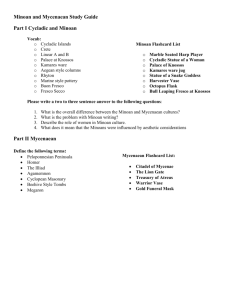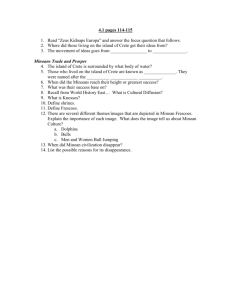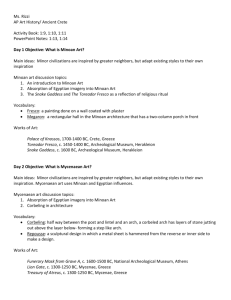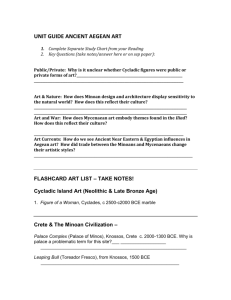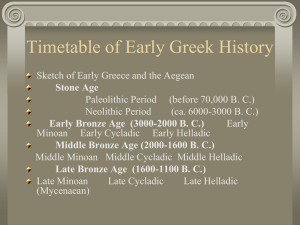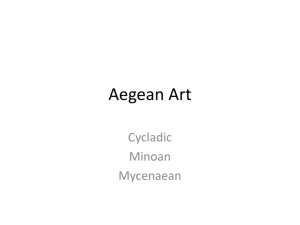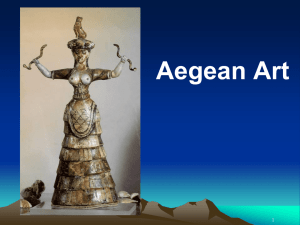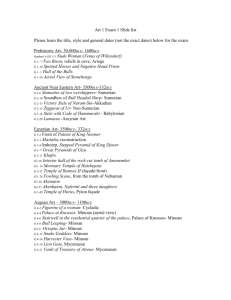Cycladic, Minoan, and Mycenaean - High Point Regional School
advertisement
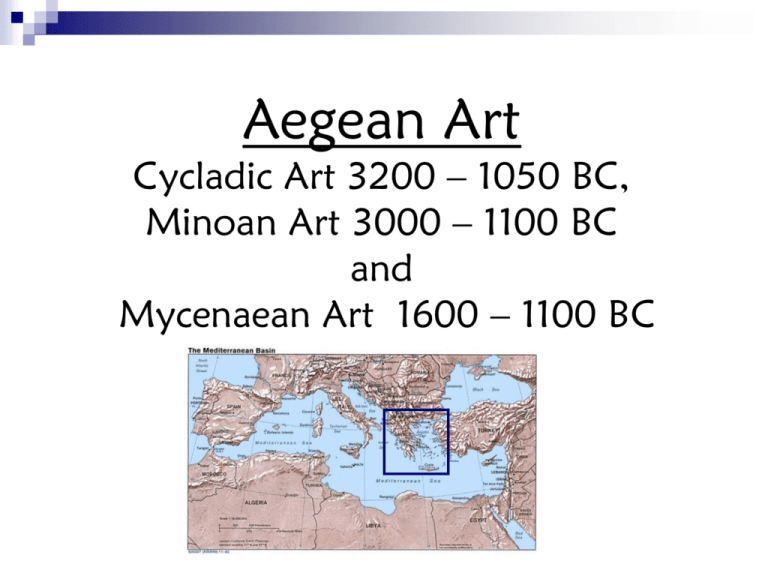
Aegean Art Cycladic Art 3200 – 1050 BC, Minoan Art 3000 – 1100 BC and Mycenaean Art 1600 – 1100 BC Cyclades Islands The Cycladic culture, active on the Cyclades, a cluster of islands in central Aegean, between 3200 and 2000 B.C., may now be studied only by its archaeological remains. Seated harp player, ca. 2800–2700 B.C.; Early Cycladic I–II Cycladic; Grotta-Pelos culture Marble; H. with harp 11 1/2 in. (29.2 cm) Rogers Fund, 1947 (47.100.1) This marble figure is one of the earliest known representations of musicians from the Early Cycladic period. It shows a man playing a harp while seated on a chair with an elaborate backrest. The musician tilts back his head and draws his lips forward as he sings. He holds the front of the harp with both hands, resting the weight of the instrument against his right leg and shoulder. His right thumb is raised as he sounds a note and listens with large hollowed ears to the resonating string. The muscles of his arms and his carefully articulated elbow joints, fingers, and ears are modeled with uncommon sensitivity. The back of this musician's head was once painted, perhaps indicating a close-fitting cap. A belt, which may be understood as part of a penis sheath, encircles his waist. On the top of the harp is an ornament carved in the shape of the head of a waterfowl. http://www.metmuseum.org/toah/ho/02/eus/hod_47.100.1.htm Cycladic Women http://www.cycladic-m.gr/ The majority of Cycladic Figurines show women, nude with the arms folded over the belly. We do not know whether they were meant to show mortals or deities, or even whether the Islanders venerated a number of deities, like the later-period Greeks, or simply worshipped one 'Mother Goddess'. In this case, the figurines may have been conceived as representations of the Goddess, or companions to her. Although male figurines were the anomaly, this figure is thought to be a male making a toast. Cycladic Pottery Cycladic pots come in different types, and this seems to suggest a variety of functions, some of which may have been ritual. Symbolism is always difficult to discern when texts or other corroboratory information is lacking, so Cycladic scholarship is often a matter of educated speculation. Objects like the clay 'frying pans', of which the Museum of Cycladic Art exhibits a representative selection, are mysterious to us. They are finely made and decorated, and do not seem to have been functional (definitely not kitchen utensils, as their nick-name might suggest). They may have been associated to sea-faring, but we possess no positive evidence to support that interpretation. http://www.cycladic-m.gr/ Minoan and Myceneaen Art Minoan art is art that comes from the island of Crete where as Mycenaean Art comes from the Greek mainland. The Mycenaeans and the Minoans actively traded and there styles were closely tied Myceneaens were known as fierce warriors and it is thought that they eventually caused the downfall of the Minoans. Minoan Pottery Pyxis, ca. 1400–1100 B.C.; Late Minoan IIIB Minoan; Greece, Crete Terracotta; Diam. 10 1/4 in. (26 cm) Gift of Alexander and Helene Abraham, in honor of Carlos A. Picón, 1999 (1999.423 Cretan exports consisted of timber, foodstuffs, cloth, and, most likely, olive oil, as well as finely crafted luxury goods. In exchange, the Minoans imported tin, copper, gold, silver, emery, fine stones, ivory, and some manufactured objects. For their basic needs, however, the Minoans on Crete were self-sufficient. During this period, great strides were made in metalworking and pottery— exquisite filigree, granulated jewelry, and carved seal stones reveal an extraordinary sensitivity to materials and dynamic forms. These characteristics are equally apparent in a variety of media, including clay, gold, stone, ivory, and bronze. Minoan Fresco Like their Egyptian contemporaries living 500 miles southeast of them, the Minoans illustrated figures with legs standing in profile and eyes, in profiled faces, staring at the viewer. So, the Minoans were not entirely revolutionary painters. Minoan artists did, however, figure out how to show torsos in profile. They drew bodies as working wholes, not as figures awkwardly twisted in the middle. More importantly, the outlines of their figures are rounded and lively. By comparison, the figures in Egyptian scenes appear stiff and uncomfortable. “The Fisherboy” was excavated from a house preserved beautifully by volcanic ash. Metalwork and Decoration pendent with bees, 1800-1700 b.C. gold, lenght 0,05 m Hiraklion, Hiraklion Museum Palace of Minos at Knossos, just south of Iraklion. This was the largest and most important of the Minoan palaces in Crete, and has been partially reconstructed, chiefly by the original excavator, Sir Arthur Evans. The name “Minoan,” derived from the mythical king Minos, was used by Evans to designate the Bronze Age civilization of Crete (3000-1000 b.c.). This fresco, Three Minoan Women, looks so fresh that it could almost be a modern painting instead of a 3500-year -old artifact. The Minoans executed paintings in a technique called "fresco," which may have contributed to the liveliness of their works. Derived from the Italian word for "fresh," fresco describes paintings made by applying water-based paints to wet plaster. When dry, the plaster bonds with the color, making the painting extremely durable. The colors are vivid: red, blue, yellow, and green, as well as black and white. They are applied without shading, in flat, bright designs that are easily identifiable, even from a distance. Toreador fresco Minoan fresco 1600-1400 B.C The Mycenaean octopus vase is highly stylized, unlike the more naturalistic Minoan vase. The Minoan octopus vase, known as the Dendra Vase, is a famous example of the naturalistic, fluid, style that characterizes Minoan painting. Mycenaean is the term applied to the art and culture of Greece from ca. 1600 to 1100 B.C. The name derives from the site of Mycenae in the Peloponnese, where once stood a great Mycenaean fortified palace. Mycenae is celebrated by Homer as the seat of King Agamemnon, who led the Greeks in the Trojan War. Lion’s Gate Fortress Mask of Agamemnon Mycenean golden death mask 1350 B.C. An example of repousee. A process that involves hammering metal. Wall Painting (from the Palace of Nestor) Depicting a Mycenaean Warrior Lyre Player (also from the Palace of Nestor) Ivory pyxis (jewel box) from a tomb at Thebes, Mycenaean period, 13th century BC Goldwork Vaphio Cup, c. 1500 B.C Royal Tomb (Tholos) socalled Treasury of Atreus, c. 1300-1250. A Prelude to Classical Greek Art? The Harvest Rython was made of steatite (green-brown soapstone) and exhibits in low relief a group of peasants walking to, or returning from olive harvest. The bare stone vase we see today was originally gilded with gold hammered to paper-thin thickness (gold leaf). The overlapping bodies create an orderly unit of forms while the raised sticks (for shaking the olive trees) above their heads generate a band of chaotic rhythmic motion. While the composition is exquisite in itself, the expression of the figures is unprecedented. The manifestation of human emotions in the faces of the figures has not been witnessed in the history of art prior to the Minoans, and the depiction of the face as the vehicle of human emotions reveals a people who were increasingly aware of the human condition and inner world. The human being and his inner world as the center of attention, along with the importance of emotions became a central driving force during the later Classical and Hellenistic periods of ancient Greece. Eons later, during the Classical Greek period, concealment of emotions was of paramount importance in art as well as in life, while during the Hellenistic era robust exhibition of emotion in art was revered. In this respect, the joyous harvesters from Agia Triada, provide a minute point of reference for the direction the cultural compass of western man was beginning to point towards: the direction inward towards one's self.
